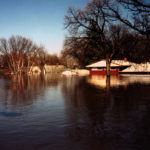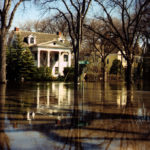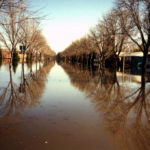Residential Flood Protection

If the devastating 1997 flooding of the Red River in our hometown of Grand Forks taught us anything, it’s that water is a force to be reckoned with. Due to water’s unpredictable and powerful nature, flooding is one of the most common and expensive natural disasters in the United States. Flash flooding from heavy rains and storms, overbank flooding from rivers and even large-scale flooding from heavy snowfalls or fast winter melting make our homes susceptible to flood damage.
Fully protecting a home from flooding is a significant undertaking. It oftentimes involves more than temporary barriers or flood planks. In fact, it usually requires special considerations when it comes to the infrastructure of your home, including the foundation, walls, electrical components, HVAC and plumbing systems, etc. Temporary barriers may redirect the water away from your home’s entrances, but unless your home’s structural components are watertight, you may still experience flood damage.
If your residence is in a flood-prone area and you have concerns about protecting your home from the effects of flooding, you may want to consider speaking to a contractor. PS Flood Barriers does offer temporary residential flood protection products to those who need it:
Flood Protection Tips
When it comes to residential flood protection, it’s not always economical to modify the infrastructure of your home. Here are some tips from the Federal Emergency Management Agency (FEMA) on how to reduce the risk of damage to your home and be prepared for flooding conditions.
Reducing Flood Risk (When elevating your home isn’t an option)
Source: FEMA
- Elevate building utilities – Homeowners may elevate building utility systems and associated equipment (e.g., furnaces, septic tanks, and electric and gas meters) using a variety of techniques, including using elevated pedestals or platforms for outdoor equipment, moving equipment to higher floors or attic spaces, and building an elevated utility room. You may also want to consider placing outdoor equipment behind floodwalls or placing indoor equipment behind a wall or watertight, passive utility enclosure.
- Use flood-resistant materials – The use of flood damage-resistant materials such as non-paper-faced gypsum board and terrazzo tile flooring for building materials and furnishings located in flood-prone areas of your residence may help reduce damage and post-flood event cleanup.
- Utilize barriers such as flood walls and levees – Consider installing a concrete floodwall (with or without gates) or an earthen levee.
- Consider other options – Basement infills, abandoning the lowest floor (of a two-story residence), elevating the lowest interior floor within a residential building with high ceilings, and installing openings in the foundation are options to help protect your home from flood damage. However, these options may not be feasible for some homeowners.
How To Prepare For A Flood
Source: FEMA
- Know your flood risk – Learn if you live, work, or travel through areas that are prone to flooding. To help communities understand their risk of flooding, FEMA creates flood maps (Flood Insurance Rate Maps, or FIRMs) to show the locations of high-risk, moderate-to-low risk and undetermined risk areas. Check your flood risk.
- Stay informed – Monitor the weather reports provided by your local news media, check the National Weather Service, sign up for text or email alerting systems in your area and consider buying a NOAA Weather Radio (NWR) All Hazards receiver. You’ll also want to plan ahead for if you lose power.
- Heed warnings – Whether it’s a flood/flash flood watch, flood/flash flood warning or evacuation notice, you should take the notifications seriously and leave or be prepared to move to higher ground quickly.
- Plan your evacuation routes – Identify several escape routes (if roads are blocked), keep your car fueled and prepped with emergency supplies, have a plan on where you can stay if you need to leave for an extended period of time, prepare and store supplies so you can grab them quickly and don’t forget about your pets.
- Reduce the risk of damage to your property – Make sure your sump pump is working, clear debris from gutters and downspouts and move furniture and valuables/important documents to a safe place.
- Consider flood insurance – Talk to your insurance agent about buying flood insurance, which is available to homeowners and renters.
If flooding is imminent, here are ways you can minimize potential damage to your home:
- Deploy any temporary flood barriers you may have.
- Inspect your home or basement for early warning signs of leakage. A musty smell, dampness or discoloration of the walls could all mean that water is seeping into your home.
- Shut off the electricity at the breaker level and unplug any electrical appliances (only if water is not yet present).
- Move furniture and electronics and other valuables to upper levels of your home.
- Elevate major appliances onto concrete blocks if you can.
- Remember to stay tuned to local news so you’re up to speed on what to do and where to go if the flooding becomes severe or dangerous.













